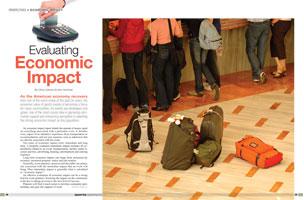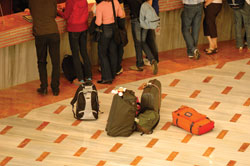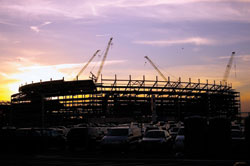
 As the American economy recovers from one of the worst crises of the past 50 years, the economic value of sports events is becoming a focus for many communities.
As the American economy recovers from one of the worst crises of the past 50 years, the economic value of sports events is becoming a focus for many communities.
As events are developed and grown, one of the most crucial roles in garnering community support and enhancing perception is reporting the strong economic impact on the population.
An economic impact report details the amount of money spent on everything associated with a particular event. It includes every aspect of an attendee's experience from transportation to accommodations and not just expenses such as admission that are directly associated with the event.
Two types of economic impact exist: immediate and long term. A properly evaluated immediate impact includes all expenditures related to an event: transportation, facility rental, licenses and fees, advertising, housing, entertainment and catering expenses.
Long term economic impact can range from increased tax revenues, increased property values and job creation.
 Generally, event planners, sponsors and the public are primarily concerned with the immediate impact that an event will bring. Thus, immediate impact is generally what is calculated as "economic impact."
Generally, event planners, sponsors and the public are primarily concerned with the immediate impact that an event will bring. Thus, immediate impact is generally what is calculated as "economic impact."
An effective evaluation of economic impact can be a strong tool for event planners. Knowing the impact on the community is the key to taking an event to the next level of success.
Planners will find it much easier to develop community partnerships and gain the support of local businesses with strong economic impact numbers.
Hotels, restaurants, entertainment venues, retail shops and other hospitality businesses will be much more willing to provide sponsorship and advertising dollars when an event shows a positive economic impact to their business.
Additionally, economic impact figures provide hard facts for developing supplementary infrastructure to sustain sports events. For example, the city of Rome, Georgia, realized the importance of the NAIA Football National Championship in their community after it posted nearly $2 million in economic impact. From these facts, the community passed a Special Purpose Local Option Sales Tax (SPLOST) to renovate and enhance the community football stadium with millions of dollars in improvement including the installation of artificial turf, track resurfacing to accommodate college-level track & field events, a digital score board and major improvements to lighting, locker rooms, concession areas and the press box. As a result, the city is currently in negotiations with the NAIA for an extended contract to continue hosting the championship game. One of the greatest advantages of determining an event's economic impact is developing community support through understanding of the positive impact on their community.
 Event planners have several options for evaluating economic impact.
Event planners have several options for evaluating economic impact.
Research firms offer the most reliable and dependable data. Firms have specialty survey techniques that can determine an estimate of impact as a pre-event estimation or a post-event review.
By compiling an economic impact estimate prior to the event, event planners may use the estimate to assist in sponsorship development.
However, the most accurate and successful impact estimates come by having a researcher at the event to determine the impact. Certain firms will also recommend changes to the event for greater economic value in the future.
Many private research firms, however, can be too expensive for the already tight budgets that most event planners face in today's economy. Instead, many smaller event planners are beginning to evaluate their own economic impact.
 In determining economic impact, it's important to consider all areas of potential impact including accommodations, advertising, purchases, facility usage, restaurants and transportation. Other specialty events could even include such items as government licenses, fees or utilities.
In determining economic impact, it's important to consider all areas of potential impact including accommodations, advertising, purchases, facility usage, restaurants and transportation. Other specialty events could even include such items as government licenses, fees or utilities.
To evaluate the factors of impact, an event planner must take a methodical approach to understand the elements of the event. First, the event itself should be analyzed by taking the sport and elements of the event, such as qualities of the average attendee, length of the event any unique properties, into consideration.
For example, various types of tennis tournaments are evaluated in different ways. A standard adult league regional tournament will generally see adults traveling together as a team, but without their family; on the opposite end of the spectrum, a junior tournament will see at least one parent travel with each player because of their age. This simple factor will cause a great difference in the economic impact of each tournament; therefore, they should be calculated differently.
Basic methods for calculating economic impact determine average spending per person during a set time period, such as the duration of an event. When multiplied by the total number of visitors, the amount of direct, immediate economic impact is realized.
 |
| © Georgios Ampartzidis - Dreamstime.com |
There are several methods for determining an event's impact. Planners or researchers can either collect research data from the attendees directly or use secondary data.
Different types of surveys can be used to collect information: on-site verbal interviews, written responses, post-attendance internet surveys; no matter the type of survey, the information collected should be detailed estimates of expenditures.
Many event planners will benefit from results that are broken down into categories such as accommodations, food, entertainment, etc. By breaking down the real impact of attendees into categories, planners will have an easier time influencing potential sponsors with their statistics.
For example, a local restaurant would be much more likely to support a rodeo through donations and sponsorships if there are hard statistics showing that the local restaurants benefited from the event in past years.
Collecting data directly can be time-consuming and expensive. While primary research can yield more accurate and specific results than secondary source estimation, the expense involved through personnel and surveying materials can be costly. Thus, figuring economic impact from secondary sources is often the more logical decision for event planners.
 |
| © Peter Kim - Dreamstime.com |
To calculate economic impact using secondary sources, event planners should consult either the local destination management organization (such as a Convention and Visitors Bureau) assisting with their event, or a state department of economic development. These government organizations have likely completed studies of events held in the local area or state that are comparable to any event. Being experts in the tourism and event industry, they will provide high-quality assistance in calculating economic impact. Often, they will be able to assist in determining the attendees' placement in a variety of profiles such as local, overnight, multi-day, etc.
Even with secondary sources, it is important to have an accurate count of attendees and their characteristics, and to know the patterns of action of the attendees. Therefore, even though secondary data may be used to calculate the numbers, basic qualities of the attendees must still be accounted for.
In recent years, journalists have started to question event planners, DMOs and CVBs more concerning economic impact. Several high-profile organizations have drastically overestimated the economic impact of major events, consequently influencing their credibility. A study in The Sports Journal titled "Upon Further Review: An Examination of Sports Event Economic Impact Studies" found that "economic impact studies are highly subjective and vulnerable to significant error as well as manipulation." Because of the complex and subjective nature of economic impact studies, results should be viewed as an estimate and not an exact figure.
While we should strive to produce the most accurate economic impact figures possible, the cost of figuring the impact increases with accuracy. Thus, we must find a balance that is cost-effective, but also highly accurate. Because tourism is now seen as a portal for jump-starting money into local economies, it is assumed that the other industries in the community will greatly benefit and grow as tourism grows.
 |
| © Diademimages - Dreamstime.com |
The concept of a multiplier is based on the idea that money spent in a community at one business will circulate in the community as the first business purchases goods from another business in the same community. A multiplier is used in the calculation of economic impact to account for this circulation. By reporting economic impact without a multiplier, the figure only includes immediate impact. When calculating with a multiplier, the long-term effects of the event such as job creation and tax-base increases are included.
However, David Egan and Kevin Nield found in The Journal of Hospitality and Tourism Management (August 2003) that the concept of a multiplier significantly overestimates the impact of a tourism event on the economy.
The overestimation of a multiplier could be due to two factors. Many communities do not possess the types and quantities of all industries to truly circulate money in the quantity suggested by a multiplier. Secondly, with the nationalization of the majority of the hospitality industry and the industries that provide goods for it, the money impacting the community goes to national stockholders as opposed to the local community. As a result, care should be taken when using multipliers. Many organizations and agencies have ended the use of multipliers all together; however, an event planner should consult the local destination marketing organization or state agency handling their event to understand their use of multipliers.
When figuring economic impact, care should be taken considering local attendees to your event. A 2003 study in Ontario, Canada,of 97 festivals and events found that in events with fewer than 10,000 attendees, close to 90 percent came from the local community; however, as the events grew in size, the percentage of visitors rose. These statistics are important because many economists choose to exclude locals from economic impact figures. The theory is that if locals had not attended this event and spent money, they would most likely spend the same amount of money in the same community at some point. While visitors are bringing new money into a community's economy for circulation, local attendees are simply reallocating the money they spend.
By removing locals, you drastically affect the economic impact number. For one festival in Ontario, an event with $1 million economic impact could be reduced to an impact of less than $100,000 if over 90 percent of attendees are local. However, for these issues that could negatively affect the economic impact, event planners can increase an event's economic impact with careful planning before the event.
Events with maximum economic impact are large events that draw a regional crowd without many locals. If an overnight stay is not required, the economic impact on the community is going to be small, because the majority of impact is generated through accommodations. Additionally, any event with significant length will require more overnight stays, thus raising the impact. However, great care should be taken to ensure that attendees are non-locals with regional advertising and promotions. As an event grows with a reputation for continued success, it becomes easier to increase the non-local attendees.
Additionally, use local goods, products and services throughout the event. By using a local printer to print all advertising and collateral, an event planner is able to ethically count all that expense to economic impact because the money is going into the local economy. But, for example, if player gifts are purchased online from an overseas company, that has no impact on the economy surrounding your event area.
Overall, evaluating economic impact is an important aspect of any event. While there are challenges to making an accurate assessment, ensuring the correct calculation of economic impact can greatly increase the success of an event through sponsor developments and community support.


